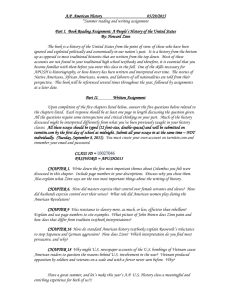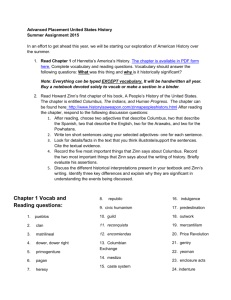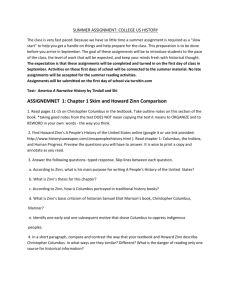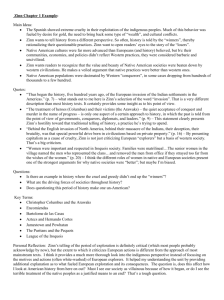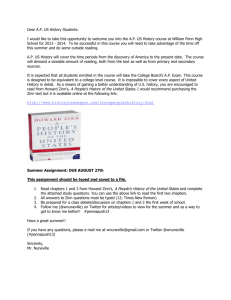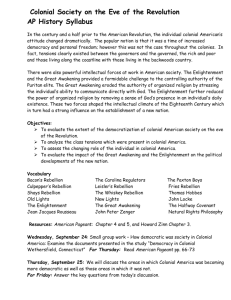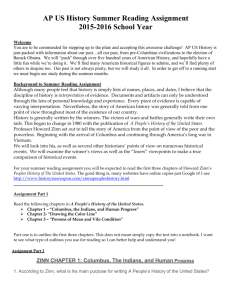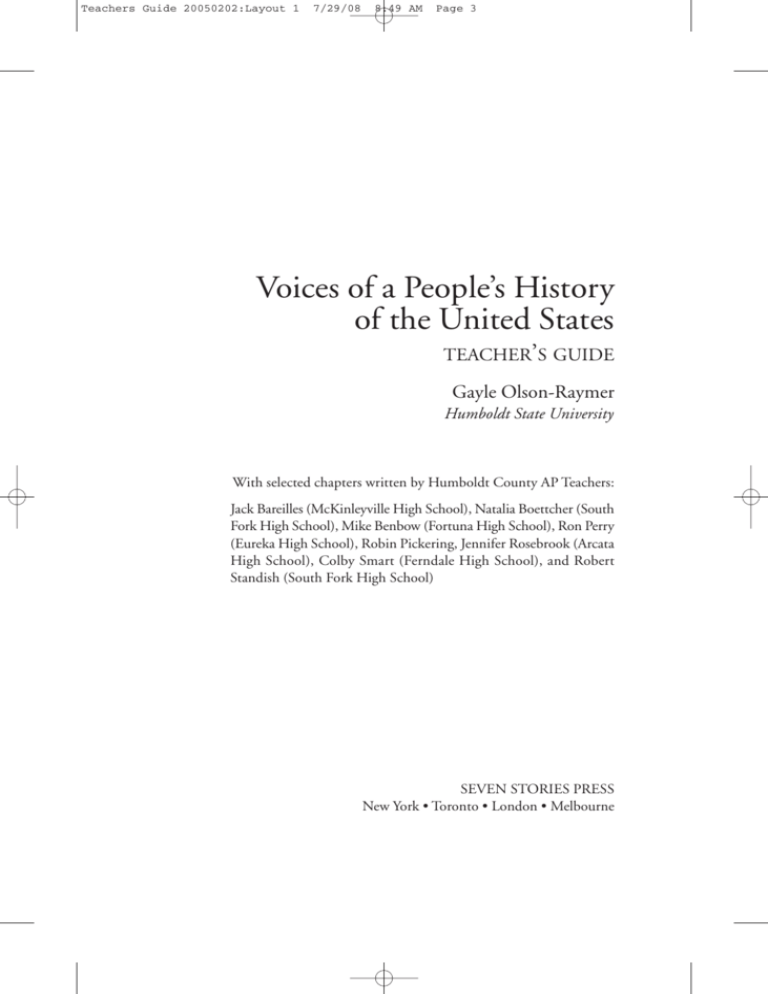
Teachers Guide 20050202:Layout 1
7/29/08
8:49 AM
Page 3
Voices of a People’s History
of the United States
TEACHER’S GUIDE
Gayle Olson-Raymer
Humboldt State University
With selected chapters written by Humboldt County AP Teachers:
Jack Bareilles (McKinleyville High School), Natalia Boettcher (South
Fork High School), Mike Benbow (Fortuna High School), Ron Perry
(Eureka High School), Robin Pickering, Jennifer Rosebrook (Arcata
High School), Colby Smart (Ferndale High School), and Robert
Standish (South Fork High School)
SEVEN STORIES PRESS
New York • Toronto • London • Melbourne
Teachers Guide 20050202:Layout 1
7/29/08
8:49 AM
Page 4
Copyright © by Gayle Olson-Raymer
All rights reserved. No part of this book may be reproduced, stored in a retrieval
system, or transmitted in any form, by any means, including mechanical, digital,
photocopying, recording, or otherwise, without the prior written permission of the
publisher.
Seven Stories Press
Watts Street
New York, NY
www.sevenstories.com
ISBN-:
--- / ISBN-: ----
College professors may order examination copies of all Seven Stories Press titles for
a free six-month trial period. To order, visit www.sevenstories.com/textbook, or fax
on school letterhead to --.
College professors who have adopted Voices of a People’s History of the United States
by Howard Zinn and Anthony Arnove as a course textbook are authorized to
duplicate portions of this guide for their students.
Design by Jon Gilbert
Printed in the U.S.A.
Teachers Guide 20050202:Layout 1
7/29/08
8:49 AM
Page 41
CHAPTER THREE
Servitude and Rebellion
Rebellion within the American colonies prior to the Revolutionary War is a topic
seldom discussed in American history classes. Yet the fiery rhetoric of freedom and
the brave actions of many colonists eventually defeated the military might of the
most powerful nation in the Western world. Why, then, are we reluctant to introduce the stories of Americans who fought not only against the British Crown, but
also against the aristocratic rule of the colonial elite? What is it that prevents us from
presenting a balanced portrayal of early America in which the diverse voices of
both the powerful and powerless are celebrated?
Perhaps part of the answer is that traditional history books and history classes
pay little or no attention to either the contributions or the grievances of the
indentured servants who journeyed to North America. Instead, these traditional
treatments of history most often describe a harmonious melting pot of colonists
who busily set about to create a classless, democratic new society. The reality is
far less harmonious and democratic, but much more interesting and real.
Indentured servants, who comprised almost fifty percent of all colonial immigrants, were among the hardest-working but poorest, most abused, and most disgruntled of all the colonists. The realities of their servitude fueled the fires of
rebellion.
Document-Based Questions
RICHARD FRETHORNE
.
What is scurvy? What is the “bloody flux”? What role did disease play in
the lives of the colonists? How does it compare and contrast with the role
disease plays in our lives today?
. Why do you think indentured servants were “not allowed to go and get”
fowl? Why do you think they never saw any deer or venison?
~ ~
Teachers Guide 20050202:Layout 1
7/29/08
8:49 AM
Page 42
~
. Who is the “enemy” in Richard Frethorne’s letter? What is his opinion of
the “enemy”?
. How do you think Frethorne’s letters might have changed, as well as
remained the same, if he was still writing to his family in the s?
COMMISSIONERS’ REPORT
.
What words do the commissioners use to describe Nathaniel Bacon? His
followers? How do these words compare and contrast with the words that
a contemporary government commission might use to describe a modern
rebellion?
. Why was Governor William Berkeley of “James Towne” “pretending to be
loath to spill bloode”? Once the battle begins, how do the Commissioners
describe the rebellion?
. How do the commissioners describe Governor Berkeley? His men? How do
you think Governor Berkeley will or will not revise colonial policies after
Bacon’s Rebellion?
PROCLAMATION OF THE NEW HAMPSHIRE LEGISLATURE
.
What were the actions of the men who were involved in the Mast Tree
Riot?
. What does the New Hampshire legislature propose to do in order that “the
utmost justice may be done to his Majestic”? Do they succeed?
LETTER WRITTEN BY WILLIAM SHIRLEY
.
Howard Zinn’s introduction to this letter explains that the riot described
is in response to impressment. What is impressment?
. How were militias raised in colonial America? What was the purpose of
“the militia of the town? What did it accomplish?
. Why does Governor William Shirley decide to stop “parleying with the
mob”? How do our current governors at the state and federal level feel
about such a word exchange?
Teachers Guide 20050202:Layout 1
7/29/08
8:49 AM
Page 43
~
MITTELBERGER’S JOURNEY TO PENNSYLVANIA
.
Keeping in mind the -year differences between the two letters, how does
Gottlieb Mittelberger’s account of indentured servitude compare and contrast with that of Frethorne?
. How does Mittelberger’s discussion of the ship’s passage to and life in North
America compare and contrast with that of the circumstances endured by
slaves?
. By , when Mittelberger embarked upon his journey, he must have been
aware of some of the hardships awaiting him. Why, then, do you think he
and thousands of others came to America?
NEW YORK TENANT RIOTS
.
Why were local farmers living on land claimed by Van Rensselaer?
. Was the treatment of the local farmers by Van Rensselaer’s army legal?
. From reading this account, what role do you think private property played
in the hearts and minds of these colonists? Did everyone have access to private property? Why, or why not?
Main Points in Voices, Chapter 3,
“Servitude and Rebellion”
After reading Chapter in Voices, students should be encouraged to identify
what they believe to be the main points therein. Following are five possible main
points.
.
Indentured servants played a large role in shaping the structure of and
struggles within colonial America.
. From the early years of Euro-American colonization, the colonists were
divided by social, economic, and political differences.
. Either rebellion or the threat of rebellion was a constant factor in colonial
North America.
Teachers Guide 20050202:Layout 1
7/29/08
8:49 AM
Page 44
~
. The “wandering poor” have always been a component in North American
society.
. Although servant and slave rebellions were rare, the threat of such rebellion
was constant, and masters were quite fearful.
Main Points in Voices, Chapter 3, “Servitude and Rebellion,”
and in A People’s History, Chapter 3,
“Persons of Mean and Vile Condition”
If your students are also reading A People’s History, they should be encouraged to
identify what they believe to be the main points in chapters in both books.
Following are five additional points to be stressed when Voices and A People’s History
are used together.
. The governors of colonial Jamestown had two primary motives for suppressing Bacon’s rebellion: to develop an Indian policy that would prevent
tribal unity and would instead divide-and-conquer the Indian nations and
peoples; and to teach poor whites that rebellion against the status quo had
serious consequences.
. More than half of all the colonists who immigrated to North America
before the Revolutionary War came as servants.
. While colonial North America was neither democratic nor egalitarian,
more opportunities existed for economic, social, and political advancement
than in Europe.
. The fear of rebellion encouraged the wealthy white colonial elite to develop
and implement policies designed to prevent unity among poor whites and
blacks, among Indians and blacks, and among Indian nations and other
Indian nations.
. The “hope of leveling” was the motive behind many thoughts, plans, and
actions undertaken by poor whites against the wealth and power of their
colonial governors.
Teachers Guide 20050202:Layout 1
7/29/08
8:49 AM
Page 45
~
General-Discussion Questions for Voices
While the following questions are designed for classroom discussion about all the
voices read in Chapter , they can also be rewritten and included as evaluation
tools.
.
Why do you think students seldom learn about plans to rebel, actual rebellions, and the rebellious beliefs of the American colonists? Do you think it
is important to hear these voices? Why, or why not?
. How do these voices support Howard Zinn’s contention that “the desperation of the poor was turned into profit by merchants and ship captains”
(p. )?
. What new information did you acquire about life in seventeenth-century
colonial North America? How does this information compare and contrast
with what you previously knew about life in the English colonies?
. “Important” people in powerful positions within colonial society wrote
three of these entries. What common words and phrases did they use to
describe the rebels? What do these words and phrases tell you about social
class in colonial North America?
. What do the causes of and responses to the four rebellions have in common?
How are they different?
. What were the consequences of planning and/or carrying out a rebellion
in colonial North America? Of running away from an indentured contract?
If punishments were harsh, how can we explain the relatively large numbers of planned and actual rebellions as well as runaway servants?
. How did the voices in this chapter reinforce any of the themes listed in
“Main Points in Voices”?
. Which of the voices in this chapter did you find most powerful? Least powerful? How and why?
Teachers Guide 20050202:Layout 1
7/29/08
8:49 AM
Page 46
~
General-Discussion Questions for Voices and
A People’s History
These general-discussion questions are additional questions posed for students
who have read Chapter in both books. For all questions, discussion must focus
on ways in which the materials in both chapters help students formulate and articulate their answers.
. What were the primary grievances of Bacon and his men? How do they
compare and contrast with other planned and actual rebellions discussed
in “Persons of Mean and Vile Condition”?
. Howard Zinn describes Bacon’s Rebellion as “antiaristocrat” and “antiIndian” (p. ). Provide examples from both books of both descriptions.
. Howard Zinn claims, “It was a complex chain of oppression in Virginia”
(p. ). What was this “chain of oppression”? What evidence does he provide to enforce this contention?
. What information do these two chapters provide in regard to English attitudes about crime and poverty in sixteenth- and seventeenth-century
England? How did these attitudes contribute to the colonization of North
America? How did they contribute to the ways the colonists dealt with
crime and poverty?
. How does Howard Zinn support his belief that “class lines hardened
through the colonial period” (A People’s History, p. )?
. What is a feudal-type aristocracy? An almshouse? Squatting? Who were
tenants? What does the use of these terms tell you about life in colonial
North America?
. What lessons about the “unimportant” people did the “wealthy elite” learn
by the eve of the Revolutionary War? Do you agree or disagree with
Howard Zinn’s belief that the elite purposely turned poor whites against the
Indians and blacks, as well as Indians and blacks against each other, “for the
security of the elite” (A People’s History, p. )? Why, or why not?
. What role does fear play in the voices within these two chapters?
. How does Howard Zinn describe the development of “a white middle class”
Teachers Guide 20050202:Layout 1
7/29/08
8:49 AM
Page 47
~
(A People’s History, p. )? Do you agree with his statement that the middle class would provide a “solid buffer” for the elite? Why, or why not? Do
you think this was a deliberate action by the elite? Why, or why not?
. Why do you think enslaved African Americans and indentured white servants did not organize together to end their bondage?
. White people justified the mistreatment of enslaved African Americans by
arguing, in part, that they were racially inferior. How could white masters
justify the mistreatment of white servants?
. How did the development of a middle class help keep the wealthy in power?
Evaluation Tools
SUGGESTED ASSIGNMENTS
These assignments can be adapted to meet any classroom need—homework, shortor long-term research projects, individual or group work. The end product should
be flexible, depending on teacher interest and student abilities—papers, journals,
oral reports, visual aides, and the like.
.
In , England began its Transportation policy. Learn as much as you can
about Transportation. What were the goals and accomplishments of this
British policy? How did Transportation influence colonization in North
America? Were particular colonial regions impacted more than others?
When and why did Transportation to North America end? What do you
think about the use of such a policy to punish criminals?
. Using at least three different sources, learn as much as possible about
debtor’s prison. How was it used in England? When the English colonists
used debtor’s prison in North America, was it the same system? When and
why did debtor’s prisons in North America end? Do you think people
should be imprisoned for failing to pay their debts? Why, or why not? What
happens to people who cannot pay their debts today?
. Using a search engine of choice, locate and read Bacon’s “Declaration of the
People,” written in July . What were his grievances against the colonial
government at Jamestown? Against the Indians? Do you think these were
Teachers Guide 20050202:Layout 1
7/29/08
8:49 AM
Page 48
~
legitimate grievances? Using sources from both chapters, defend your
answers.
. Many historians have claimed that in proportion to population, King
Phillip’s War was the bloodiest conflict in American history. Learn as much
as possible about the participants of this war, the goals and grievances of both
sides, and its long-term consequences.
. What were the goals, actions, and consequences of Jacob Leister’s farmer’s
revolt of ? How do they compare and contrast with the rebellions discussed in both chapters?
. Using a search engine of choice, find other voices of indentured servants who
lived in colonial North America. Do theirs echo or differ from the voices
heard in these chapters? How and why?
. For over ten years, the Association for the Preservation of Virginia
Antiquities (APVA) has funded archeological research at the original site of the
Jamestown colony. Spend some time at the Jamestown Rediscovery Project
website at http://www.apva.org/jr.html. After browsing the site, how does
this information, coupled with what you read in both chapters of the
Howard Zinn books, give you a more balanced perspective on how the ordinary colonists of Jamestown struggled to adapt to their new environment?
. Learn more about the Indian nations whose traditional lands existed on
what became Jamestown shortly after contact. Using a search engine of
choice, try to locate a first-hand voice that discusses the relationship
between the native occupants of the land and the English colonists. How
did the Indians greet the English colonists? How did the colonists treat
them? How had relationships changed by the s? What do you believe
were the primary obstacles to peaceful coexistence?
SUGGESTED ESSAY QUESTIONS
.
Describe the various types of rebellions that were planned and carried out
in colonial America. How did the goals of the rebels compare and contrast?
Which were most successful in achieving their goals? Least successful? How
and why?
. Describe at least two rebellions that occurred in the late-twentieth and
Teachers Guide 20050202:Layout 1
7/29/08
8:49 AM
Page 49
~
early-twenty-first centuries. How do the goals of these rebellions compare
and contrast with the goals of the colonial rebels?
. Describe the life of a typical indentured servant before, during, and after
immigration to North America. How did immigration change his/her life
from that which was lead in Europe? How did his/her life compare and
contrast with that of a slave?
. Support or refute Howard Zinn’s contention that “[t]he colonies . . . were
societies of contending classes” (A People’s History, p. ).
. Why is Chapter in A People’s History entitled, “Persons of Mean and Vile
Condition”? How do the voices in “Servitude and Rebellion” reinforce that
title?
. Various comparisons between life in colonial America and serfdom in
Europe are made in both chapters. Provide several examples of such comparisons and then support or refute the merits of this comparison.
. What voices of resistance in chapters in both Voices and A People’s History
were of most interest to you? How and why? Which did you find most
compelling and why? Least compelling?
. How do the voices and information in these two chapters improve your
understanding of colonial history? Do you think it is important to learn
about the voices of resistance, especially those of people who did not
achieve their goals in the course of rebellion? Why, or why not?
SIMULATIONS AND OTHER CREATIVE APPROACHES
.
Make a drawing of class structure as you think it might have appeared in
early America. Your drawing should illustrate the different conditions and
amounts of power possessed by each group you identify.
. Pick one person whom you read about or whose voice resonated with you.
Based upon what you know about his life, write a short, reflective autobiography that he might have written toward the end of his life. It might
include major accomplishments as well as regrets; stories to be passed on
to grandchildren; historical experiences to be shared with a reporter or a
historian.
Teachers Guide 20050202:Layout 1
7/29/08
8:49 AM
Page 50
~
. Create a simulation of something that might have occurred in frontier
Virginia prior to Bacon’s Rebellion. Divide the class into four or five
groups, each of which has six students who will work together to “overcome the small number of masters.” Two students in each group will represent the Indian perspective, two the slave perspective, and two the poor
white perspective. They will have twenty minutes to overcome any issues
that might divide them and to determine what they have in common, so
that they can design their response to their perceived dilemma. Each group
then reports back to the class for an overall discussion of the following: the
viability, or lack thereof, of each response; and how today’s ordinary, powerless citizens might join together in a united response against perceived or
actual injustice.
. Stage a discussion forum during which Richard Frethorne and Gottlieb
Mittelberger will discuss their experiences as indentured servants. The
attending journalists (all the students in the class who will be sitting in the
room) should have a series of politically astute questions ready for each of
these men. After Frethorne and Mittelberger speak, the journalists will have
the opportunity to ask questions of either speaker or of both. After the discussion, each student will write a short newspaper editorial summarizing
his or her understanding of Frethorne’s and Gottlieb’s experiences and recommending either that indentured servitude continue or that it be abolished within the colonies.
OTHER HOWARD ZINN TITLES AVAILABLE FROM
SEVEN STORIES PRESS
For ordering and course adoption information visit
www.sevenstories.com and www.sevenstories.com/textbook
A Young People’s History of the
United States
Adapted by Rebecca Stefoff
Zinn’s first book for young adults retells U.S.
history from the viewpoints of slaves, workers,
immigrants, women, and Native Americans,
reminding younger readers that America’s true greatness is shaped by our dissident voices, not
our military generals. The single-volume edition also includes side-bar stories of actual children
who made American history, from Anyokah, who helped bring written language to her
Cherokee people, to John Tinker, a high school student who fought all the way to the Supreme
Court for freedom of expression at school—and won.
“In many years of searching, we have not found one history book to recommend . . . until the just
published A Young People’s History of the United States. This is the edition of A People’s History that
we have all been waiting for.”—Deborah Menkart, executive director, Teaching for Change
Volume 1: From Columbus to the Spanish-American War / Paper over board 978-1-58322-759-6 $17.95 224 pages, illustrations throughout
Volume 2: From Class Struggle to the War on Terror / Paper over board 978-1-58322-760-2 $17.95 240 pages, illustrations throughout
-
Paper 978-1-58322-869-2 $19.95 464 pages, 50 b&w, illustrations and photos
Cloth 978-1-58322-886-9 $45.00 464 pages, 50 b&w, illustrations and photos
Voices of a People’s History of the United States
Second Edition
Edited with Anthony Arnove
The companion volume to historian Howard Zinn’s legendary best-selling book
A People’s History of the United States.
“Voices should be on every bookshelf. [It presents] the rich tradition of
struggle in the United States, from the resistance to the conquest of the
Americas in the era of Columbus through the protests today of soldiers and
their families against the brutal invasion and occupation of Iraq.” —Arundhati Roy
“In Voices, Howard Zinn has given us our true story, the ongoing, not-so-secret narrative of race
and class in America.” —Russell Banks
Paper 978-1-58322-628-5 $22.95 672 pages
Readings from Voices of a People’s History
of the United States
Edited by Anthony Arnove and Howard Zinn
Authors Howard Zinn and Anthony Arnove are joined on this audio
CD by Danny Glover, Sarah Jones, Paul Robeson, Jr., Lili Taylor,
Wallace Shawn, and Marisa Tomei to perform rousing words of dissent
selected from the complete anthology.
Audio CD 978-1-58322-752-7 $14.95 45 minutes
Artists in Times of War
Zinn’s essays discuss America’s rich cultural counternarratives to war, from
grassroots pamphlets to the likes of Bob Dylan, Mark Twain,
E. E. Cummings, Thomas Paine, Joseph Heller, and Emma Goldman.
“The essays are all elegantly written and relate history to the great crisis of
current times: war of aggression, western state terrorism, and obedience to
state power under the guise of patriotism.” —Tanweer Akram, Press Action
Open Media Book / Paper 978-1-58322-602-5 $9.95 160 pages
Howard Zinn on History and
Howard Zinn on War
These two companion volumes are handy pocket guides on
the power of history when it is put to the service of the
struggle for human rights, and on the meaning of war in a
world where we have so far proven unable to overcome our
primitive predilection for destroying our neighbor.
On History Paper 978-1-58322-048-1 $12.95 240 pages / On War Paper 978-1-58322-049-8 $12.95 224 pages
Terrorism and War
Edited by Anthony Arnove
Zinn explores how truth, civil liberties, and human rights become the first
casualties of war and examines the long tradition of Americans’ resistance
to US militarism.
“A significant number [of students] say that this and other books from a
radical perspective have transformed their understanding of US society,
politics, and culture.” —Darrell Y. Hamamoto, University of California, Davis
Open Media Book / Paper 978-1-58322-493-9 $9.95 144 pages
The Zinn Reader
Writings on Disobedience and Democracy, 2nd Edition
The definitive collection of Zinn’s writings on the great subjects of our time—
race, class, war, law, means and ends—now updated with thirteen recent
essays.
“A welcome collection of essays and occasional pieces by the dean of radical
American historians.”—Kirkus Reviews
Paper 978-1-58322-870-8 $21.95 752 pages
La otra historia de los Estados Unidos
“Zinn’s work is a classic of revisionist history, bringing forth voices that have
previously been muffled. He lets women, African Americans, workingclass
people, and, yes, Hispanics speak for themselves. This Spanish edition should
prove popular in both public and academic libraries.”
—Library Journal
The first Spanish-language edition of Howard Zinn’s contemporary classic, A People’s History of
the United States.
SIETE CUENTOS EDITORIAL
Paper ISBN 978-1-58322-054-2 $19.95 504 pages
THE ZINN EDUCATION PROJECT
Seven Stories is pleased to support the Zinn Education Project, a collaboration between
Rethinking Schools and Teaching for Change, dedicated to introducing middle school and high
school students to a more accurate, complex, and engaging understanding of United States
history than is found in traditional textbooks and curricula. Visit the web site to see how you
can bring Zinn’s teaching into the classroom, showing students that history is made not by a
few heroic individuals, but by people’s choices and actions. http://www.zinnedproject.org
A People’s History for the Classroom
Bill Bigelow
Activities and projects for middle school and high school classrooms, inspired by Zinn’s A People’s
History. Available from The Zinn Education Project: http://www.zinnedproject.org

